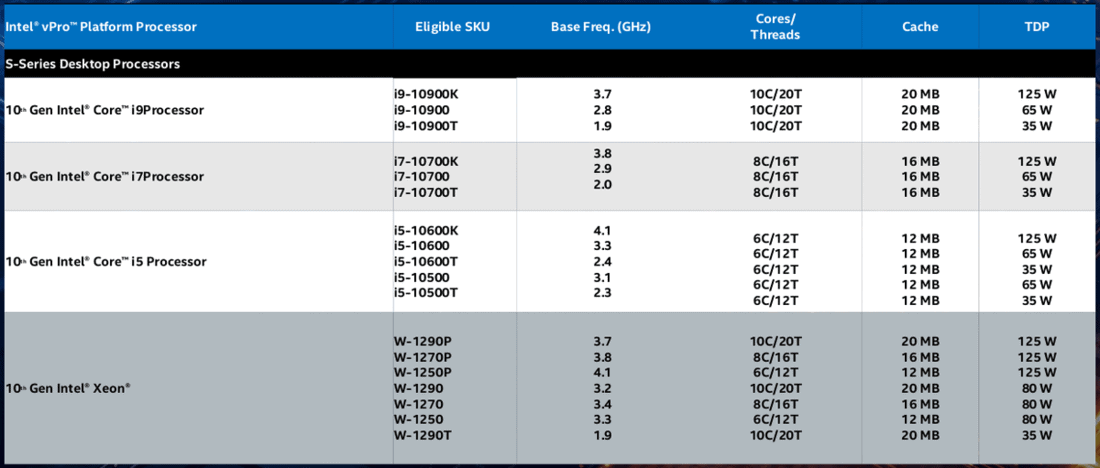Intel announced their new 14-nanometer batch of chips. In this case, it’s a set of Comet Lake CPUs that consists of mobile and 18 desktop chips — a combination of Core and Xeon chips — all bearing the vPro badge. Intel said it has made its previously optional hardware shield mandatory for this release of its 10th generation chips. “We’re doing a number of recommended and required specifications to be badged Intel vPro platform and with this round … we’re actually requiring Intel hardware shield and the technologies under it to get that badge.” “What we are doing is in the BIOS and firmware stage, where Intel obviously has a unique role, we are offering additional defensive layers, we are effectively shrinking the region that would be vulnerable to cyber attacks,” said Stephanie Hallford, Intel GM and VP for business client platforms. Hallford said Intel and Microsoft worked together to secure Windows 10 and the vPro BIOS while adding the CPU’s ability to run processes while under attack. “It’s also the BIOS itself, we have the ability to encrypt and secure additional device components that are becoming increasingly vulnerable as cyber attackers get more innovative,” the GM said. “We are implementing our advanced threat detection in addition to BIOS security, memory encryption, and communication between OSS and BIOS. And what this means in the event of an attack, we can pass many of the non-critical performance criteria to the GPU. “We are downloading the CPU to allow the CPU to concentrate on these mission-critical system capabilities and investigations, while at the same time doing all this without reducing the system’s productivity.” As for the silicon itself, Intel launches six mobile H-series chips running at 45 watts, and three mobile U-series chips sucking down 15 watts. Both Core chips of the H-series are either i9, i7, and i5, having from four to eight cores with 8 to 16 MB cache, and base frequencies ranging from 2.3GHz to 2.7GHz. A pair of Xeons are available with six or eight cores, 12 or 16 MB cache, and either 2.8GHz or 2.4GHz base frequency. The U-series is a dialed down affair, offering two i7s and one i5 with either four or six cores, 6 to 12 MB cache, and base frequencies from 1.1GHz to 1.8GHz, respectively.
Intel offers three 10-core, 20-thread i9 chips with 20 MB of cache; three eight-core, 16-thread i7 chips with 16 MB of cache; and five six-core, 12-thread i5 chips with 12 MB of cache for desktop vPro offerings, which can be used anywhere from 35 watts of power to 125 watts. Intel also provides seven Xeon processors with a choice of 10, 8, or 6 cores coupled with the same cache size found in the Core Chips. Intel also claims efficiency increases of about 40%, but with just a quarter of the new system’s RAM, it does this compared to three-year – old systems. When a contrast with a five-year-old machine was done, Intel gave the older machine the same amount of RAM, albeit obviously with slower clock speeds, and on the benchmark the new chips were only just 44 per cent faster. Hallford said the next releases of the vPro would be based on the architecture of its 10nm Tiger Lake, rather than the immediate Comet Lake Ice Lake. “In our product line decisions, we made some prioritization calls, and sadly, despite some of our initial decisions, we decided that we needed to concentrate our Ice Lake technology on the customer side and make sure we really shore up the security features on our vPro side,” she said. “Ice Lake was not going to be able to provide as much protection, given that most of our research had been built on other platforms, so we’re not going to be offering it on Ice Lake. You’ll see our new Tiger Lake vPro as our next platform after Comet Lake.” The new vPro Comet Lake chips do have built-in Wi-Fi 6. AMD announced last week its Ryzen Pro 4000 business laptop series of processors that use 15 watts. It is expected the Zen 2-based chips will be available within the first half of the year.

